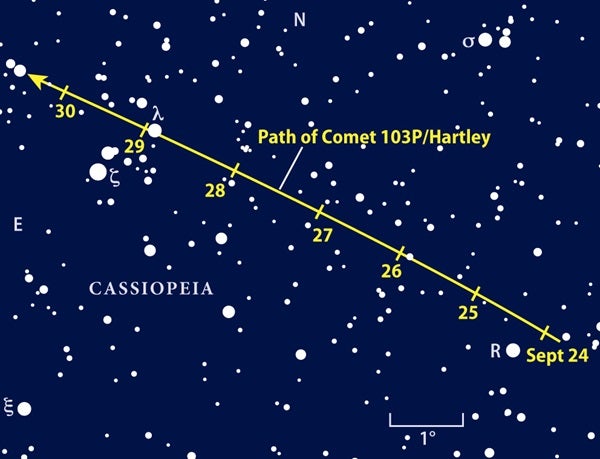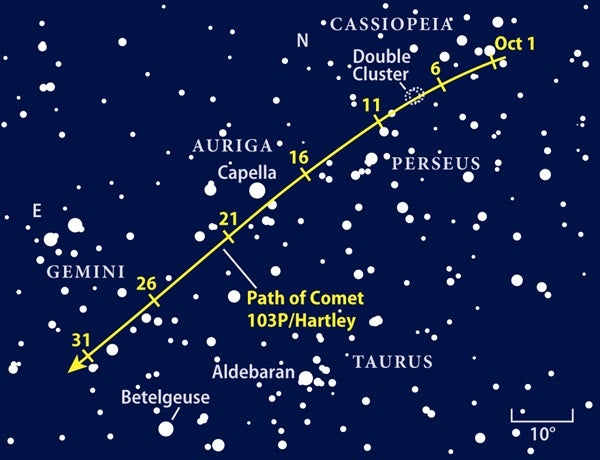The brightest comet of the year starts to put on a good show in late September before reaching its peak in October. When Comet 103P/Hartley glows at its brightest, it should be visible with naked eyes under a dark sky.
Australian astronomer Malcolm Hartley discovered this comet in March 1986. It orbits the Sun once every 6.5 years, traveling from just outside the orbit of Jupiter to nearly Earth’s distance from the Sun. This is the comet’s fourth return to the inner solar system since it was discovered, and its best one yet.
Comet 103P/Hartley should peak at 5th magnitude when it passes closest to Earth in October. A 5th-magnitude star is bright enough to see with naked eyes if you’re out of the city, but a comet’s light spreads out, making it harder to see. Still, you’ll have a good chance to see it without optical aid from a dark-sky site. Binoculars will show the comet nicely, and a telescope will let you see details.
You can start looking for the comet in late September when it lies in the constellation Cassiopeia and remains visible all night. It passes near the star Lambda (λ) Cassiopeiae the night of September 29.
Comet 103P/Hartley should show two tails emanating from a roughly circular glow, known as the “coma,” which masks the comet’s nucleus. The nucleus is a giant ball of ice and dust that measures about a mile across. As sunlight hits the nucleus, the ice boils off and carries dust with it. This cloud of gas and dust forms the coma.
Sunlight ionizes the ejected gas molecules, causing then to glow with a bluish color. The solar wind carries this ionized gas away from the comet, creating a straight, bluish gas tail. The ejected dust gets pushed away from the Sun more gently, so it forms a curving tail. The dust particles simply reflect sunlight, so the dust tail has a white to pale-yellow color.
Although October marks the peak for Comet 103P/Hartley, the comet will continue to make news in November. NASA’s EPOXI mission will fly past the comet and return stunning images of its nucleus. EPOXI comes closest to the comet November 4, and NASA should release fresh images soon thereafter.
- Australian astronomer Malcolm Hartley discovered this comet in March 1986. When it returned to the inner solar system in September 1991, astronomers firmly established its orbit. Because it was the 103rd periodic comet to be recognized, it received the designation “103P.”
- This comet is the second of three periodic comets Malcolm Hartley has discovered. For this reason, it also goes by the name “Hartley 2.”
- NASA’s EPOXI mission was known as Deep Impact when it flew past Comet 9P/Tempel in 2005. The spacecraft then consisted of two parts: a massive impactor that collided with the comet and a flyby spacecraft that recorded the results. The impact created a bright flash of light as it vaporized a small chunk of the nucleus. The flyby craft lives on as EPOXI.
- Video: Follow along with the video transcript of “Comet 103P/Hartley reaches its peak.”
- StarDome: Locate Comet 103P/Hartley in your night sky with our interactive star chart. To ensure the comet is displayed, click on the “Display…” drop-down menu under Options (lower right) and make sure “Comets” has a check mark next to it. Then click the “Show Names…” drop-down menu and make sure “Comets” is checked there, too.
- Images: Submit images of Comet 103P/Hartley to our Online Reader Gallery.
- Discussion: Ask questions and share your observations in our Reader Forums.
- Sign up for our free weekly e-mail newsletter.












